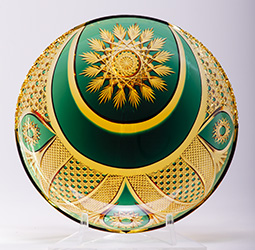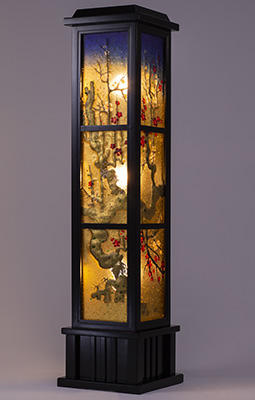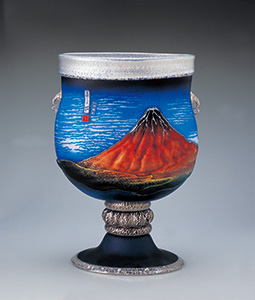November 2022
- English
- 日本語
A Glass Artist Expressing Traditional Japanese Beauty in Glass

Glass artist Kuroki Kuniaki

Korin-Rinpa series vase with gold and platinum inlay (H: 49.6 cm x ϕ: 31 cm) 
Aya Kiriko series plate (three layers, two colors) (H: 7 cm x W: 33 cm) 
Korin-Rinpa series andon lantern with gold and platinum inlay (H: 128 cm x W: 32 cm x D: 32 cm) 
Vase based on The South Wind, Clear Sky, one of the Thirty-six Views of Mount Fuji series of prints by Katsushika Hokusai (H: 54 cm x W: 38 cm x D: 30.5 cm)

Glass artist Kuroki Kuniaki continues to fascinate many people both at home and abroad through his glass crafts, expressing natural beauty and traditional Japanese aesthetics found in paintings and other classical works of art.

Kuroki Kuniaki is known as a leading Japanese glass artist and has produced numerous works over the past 60 or so years. Born in 1945, and now in his late 70s, Kuroki presides over Glass Art Kuroki, a glass craft workshop in the town of Aya, Miyazaki Prefecture (close to his own hometown), which has rich natural surroundings and one of the largest remaining warm-temperate (evergreen broadleaf) forests in Japan.
Kuroki first began working with glass almost 60 years ago. After graduating from high school in Miyazaki Prefecture he found a job at a glass manufacturer in Tokyo, on the recommendation of his art teacher. “When I was being shown around the company on the day I first came to Tokyo, I saw a pile of cullet* in a corner of the factory, sparkling in the sunlight from the West. They were just glass fragments that were to be thrown out as waste, but to me they looked more beautiful than jewels,” Kuroki recalls.

After starting work at the glass factory, Kuroki honed his artistic senses by attending art school at night and visiting museums on his days off, sparing little time even for sleep.
It was around that time that he encountered the works of Ogata Korin (1658–1716)—a leading painter and craftsman in the world of Japanese art who was active during the 17th and 18th centuries—and other artists of the Rinpa** school, which centered around him. “When I saw Korin’s signature masterpiece—Red and White Plum Blossoms—before my eyes at the Tokyo National Museum, I was so moved that I became rooted to the spot,” says Kuroki.

In 1984, after honing his skills at the glass factory for over 20 years, Kuroki began work as an independent creator. Over the course of almost 60 years, he has produced a truly wide variety of works, including the Korin-Rinpa series, in which he expressed Japanese culture and beautiful natural scenery using traditional Japanese aesthetics, as found in the paintings of Korin and other Rinpa artists. He created glassware with splendorous gold and colorful, graceful inlays***; andon lanterns using glass instead of washi paper; and homages to ukiyo-e prints by artists such as Katsushika Hokusai and Utagawa Hiroshige. His creations—made by layering glass inlaid with small glass parts and other materials such as gold leaf—radiate Japanese beauty with a delicate but luxurious feel, owing to the depth of light and color.
Kuroki is also particular about the way his works are displayed, placing many of them on mirrors so that the whole work shines beautifully with not only the light from above but also the reflected light from below.

“Glass crafts are created at high temperatures of around 1,200 degrees Celsius, and their color does not fade even after 1,000 years—so the traditional Japanese beauty expressed in the glass can be enjoyed forever, as long as it is not broken,” explains Kuroki. “On the other hand, glass is also transparent, so it can’t hide parts where I couldn’t finish the work well, which is why I’ve always continued to pursue and refine new techniques and expression.”
In 1991, Kuroki became the first glass artist in Japan to receive the award of Contemporary Master Craftsman (Outstanding Technician). In 2008, he successfully held a two-month exhibition showcasing about 100 of his works at a museum in Venice, Italy—which is known as a special place for glass crafts—and received rave reviews from many people, including local glass art experts.
In recent years, Kuroki has been working on the Aya Kiriko series of multicolored kiriko cut glass, themed around the warm-temperate forest of Aya—which was registered as a UNESCO Biosphere Reserve (or so-called “eco-park”) in 2012. These works are instilled with a strong desire to pass on Japan’s wonderful nature to future generations through the never-fading brilliance of glass.
* Waste glass that has been accidentally or purposefully broken.
** Rinpa is a major school of Japanese painting, crafts and calligraphy active in the seventeenth and eighteenth centuries. Works are characterized by bold compositions and the use of gold and silver leaf for backgrounds. Ogata Korin’s Red and White Plum Blossoms is said to be its greatest masterpiece, alongside other famous works such as Korin’s Irises and Tawaraya Sotatsu’s Wind God and Thunder God (all painted on traditional folding screens).
*** One of the decorative techniques used in handicrafts. The pattern is created by carving metal, wood, ceramics, or other earth materials and inlaying other materials such as gold, silver, or shells into the carved material.

